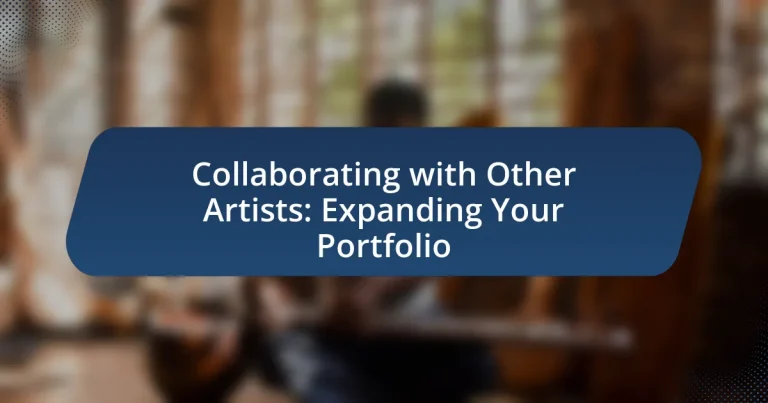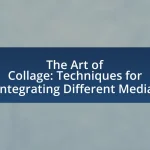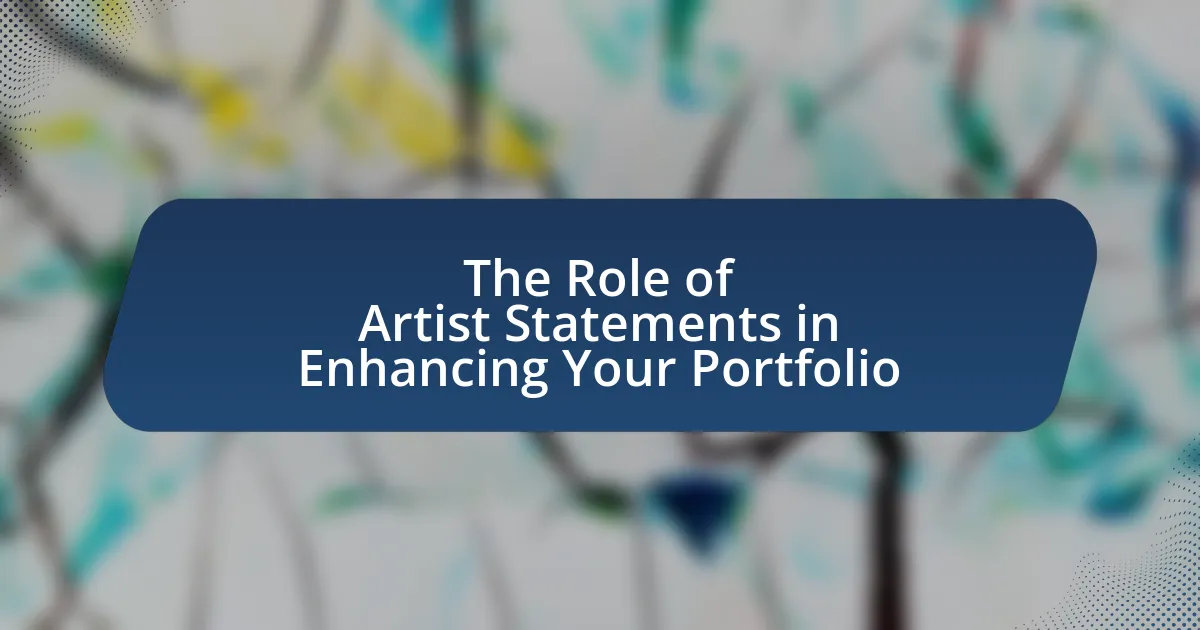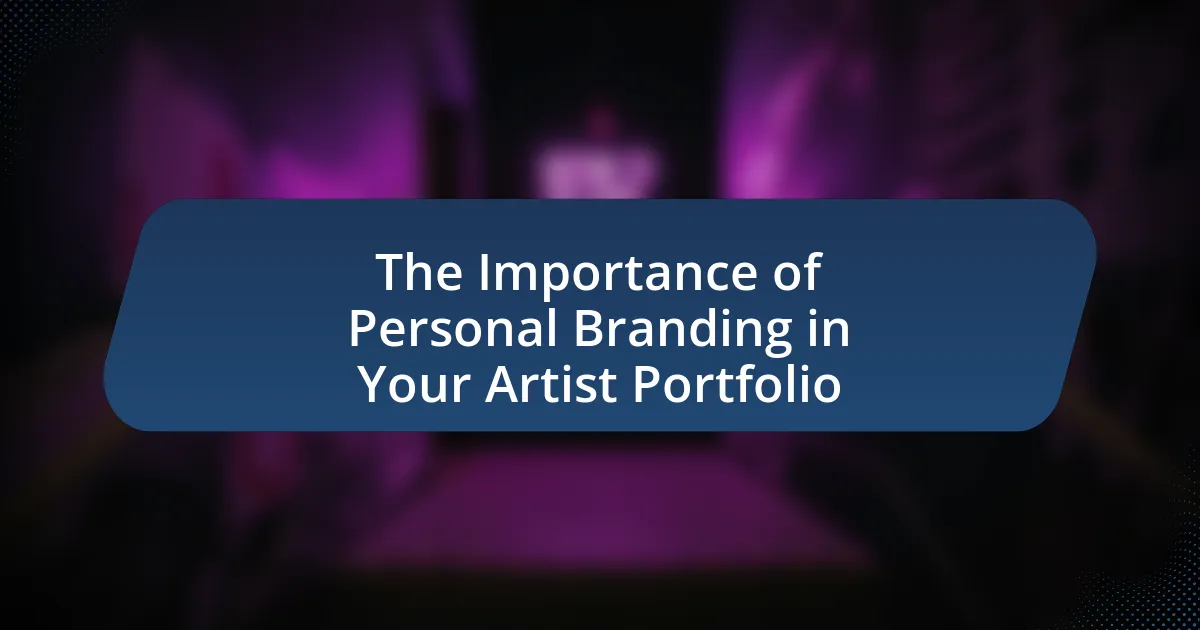The article focuses on the significance of collaborating with other artists to enhance creativity and expand artistic portfolios. It outlines the collaborative process, including brainstorming, task division, and the integration of diverse styles, which can lead to innovative outcomes. Various forms of artistic collaboration, such as interdisciplinary projects and mentorship, are discussed, along with the benefits of networking and communication skills development. Additionally, the article highlights strategies for finding collaboration opportunities, maintaining effective communication, and navigating challenges that may arise during collaborative efforts. Overall, it emphasizes how collaboration can broaden an artist’s audience and improve their visibility in the art community.
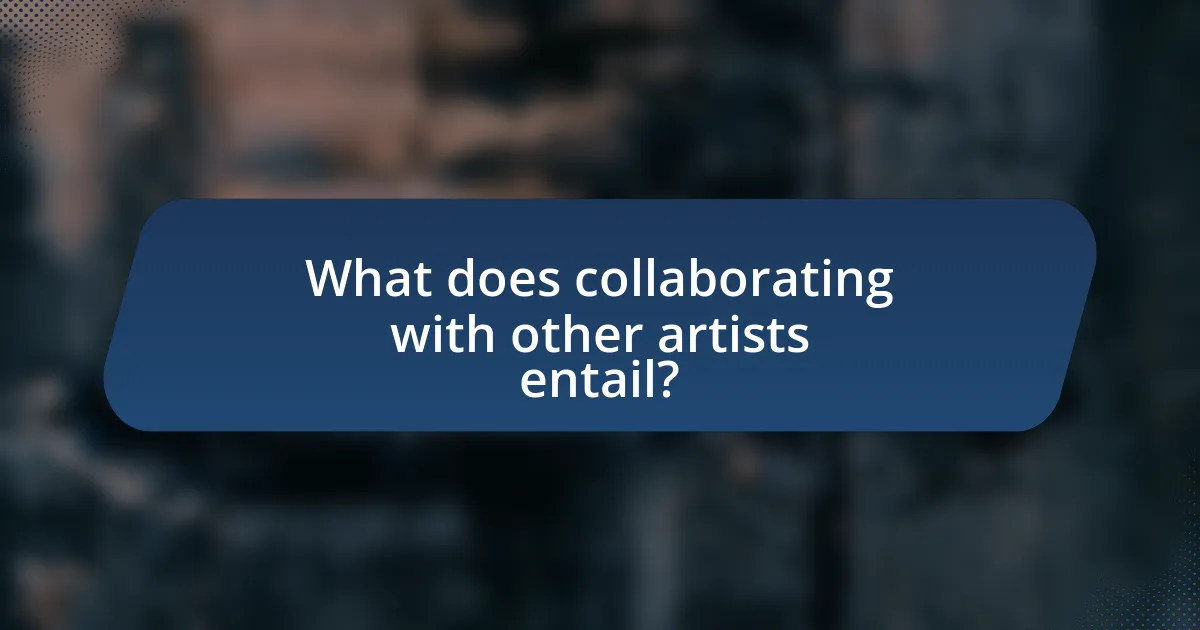
What does collaborating with other artists entail?
Collaborating with other artists entails working together to create a shared artistic project, combining individual skills and perspectives to enhance creativity and output. This process often involves brainstorming ideas, dividing tasks based on each artist’s strengths, and integrating various styles and techniques to produce a cohesive final piece. Collaboration can lead to innovative results, as seen in successful partnerships like the collaboration between musicians Daft Punk and Pharrell Williams, which produced the hit “Get Lucky,” showcasing how diverse talents can merge to create something unique and commercially successful.
How can collaboration enhance an artist’s portfolio?
Collaboration can enhance an artist’s portfolio by introducing diverse styles and techniques that broaden the artist’s creative range. When artists work together, they can share unique perspectives and skills, resulting in innovative works that may not have been possible individually. For instance, a visual artist collaborating with a musician can create multimedia projects that showcase both visual and auditory elements, attracting a wider audience. This collaborative approach not only enriches the artist’s body of work but also demonstrates versatility and adaptability, qualities that are highly valued in the art community.
What are the different forms of artistic collaboration?
Artistic collaboration takes various forms, including interdisciplinary collaboration, co-creation, collective projects, and mentorship. Interdisciplinary collaboration involves artists from different fields, such as visual arts and music, working together to create a unified piece. Co-creation refers to artists jointly developing a work, sharing ideas and responsibilities throughout the process. Collective projects involve groups of artists contributing to a single theme or exhibition, fostering a sense of community and shared vision. Mentorship occurs when experienced artists guide emerging talents, facilitating skill development and creative exchange. Each form enhances creativity and broadens artistic perspectives, as evidenced by successful collaborations in art history, such as the partnership between composer John Cage and visual artist Robert Rauschenberg.
How do collaborations influence an artist’s style and technique?
Collaborations significantly influence an artist’s style and technique by introducing new perspectives and methodologies. When artists work together, they often share their unique approaches, which can lead to the blending of different styles and the exploration of innovative techniques. For instance, a visual artist collaborating with a musician may incorporate rhythmic patterns into their artwork, while a painter might adopt color palettes inspired by the collaborator’s musical themes. This cross-pollination of ideas not only enhances creativity but also allows artists to reach broader audiences, as seen in successful partnerships like that of Andy Warhol and musicians in the 1960s, which expanded both their artistic expressions and commercial appeal.
Why is collaboration important in the art community?
Collaboration is important in the art community because it fosters creativity and innovation through the exchange of diverse ideas and perspectives. When artists collaborate, they combine their unique skills and experiences, leading to the creation of more complex and engaging works. For instance, a study by the National Endowment for the Arts found that collaborative projects often result in higher-quality art and increased audience engagement, demonstrating that teamwork can enhance artistic output.
What role does networking play in artistic collaboration?
Networking is essential in artistic collaboration as it facilitates connections between artists, enabling the sharing of ideas, resources, and opportunities. Through networking, artists can meet potential collaborators, gain access to diverse skill sets, and enhance their creative projects. For instance, a study by the National Endowment for the Arts highlights that artists who actively network are more likely to engage in collaborative projects, leading to innovative outcomes and expanded visibility in their fields. This demonstrates that effective networking not only fosters collaboration but also contributes to the growth and success of artists’ portfolios.
How can collaboration foster creativity and innovation?
Collaboration fosters creativity and innovation by combining diverse perspectives and skills, leading to unique ideas and solutions. When individuals from different backgrounds work together, they share knowledge and experiences that can inspire new approaches. For instance, a study published in the Journal of Creative Behavior found that collaborative teams produced more innovative outcomes compared to individuals working alone, as the interaction among team members stimulates creative thinking. This synergy not only enhances problem-solving capabilities but also encourages risk-taking, which is essential for innovation.
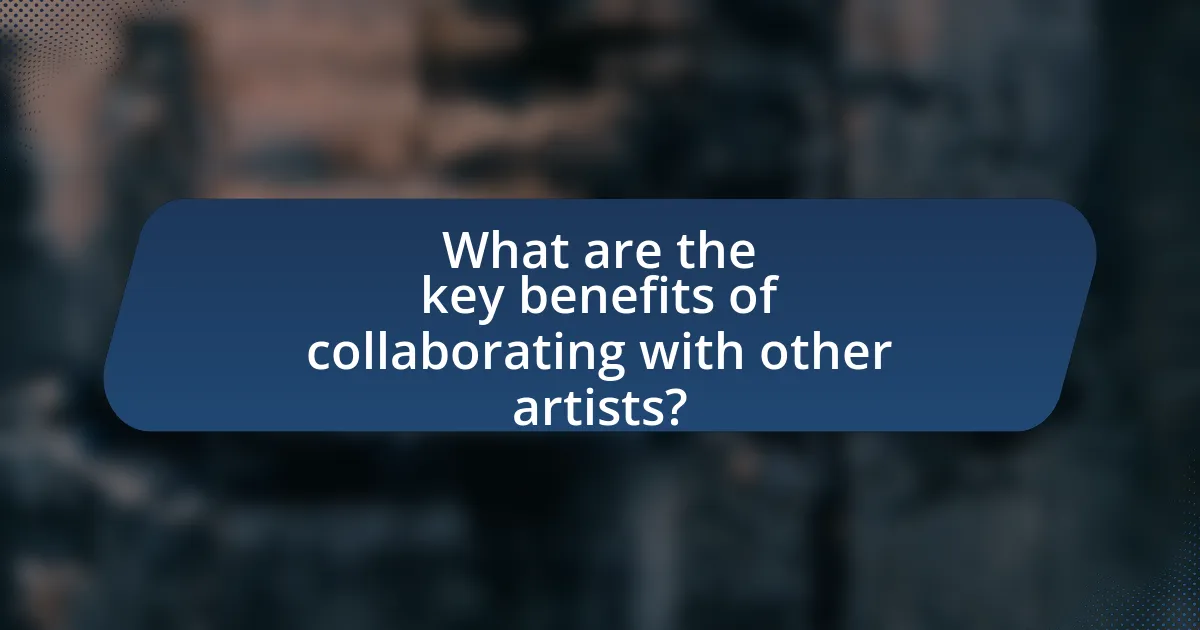
What are the key benefits of collaborating with other artists?
Collaborating with other artists enhances creativity and broadens skill sets. This partnership allows artists to share diverse perspectives, leading to innovative ideas and unique projects. For instance, a study by the National Endowment for the Arts found that collaborative projects often result in higher quality work due to the combination of different techniques and styles. Additionally, collaboration can expand an artist’s network, providing access to new audiences and opportunities for exposure. This is supported by data from the Creative Industries report, which indicates that artists who collaborate are more likely to gain visibility and recognition in their fields.
How does collaboration expand an artist’s audience?
Collaboration expands an artist’s audience by allowing them to tap into the fan bases of their collaborators. When artists work together, they combine their unique styles and reach, which can introduce each artist to new listeners who may not have been previously aware of their work. For instance, a study by the University of Southern California found that artists who collaborate often see a significant increase in streaming numbers and social media engagement, as they benefit from cross-promotion. This synergy not only enhances visibility but also fosters a diverse creative environment that attracts a broader audience.
What strategies can artists use to reach new audiences through collaboration?
Artists can reach new audiences through collaboration by engaging in joint projects that combine their unique styles and fan bases. Collaborative efforts, such as co-creating artwork, music, or performances, allow artists to tap into each other’s networks, thereby increasing visibility. For instance, a visual artist partnering with a musician can attract both art enthusiasts and music fans, effectively broadening their audience reach. Additionally, participating in group exhibitions or collaborative events can introduce artists to new demographics, as seen in initiatives like the “Art Basel” fairs, which showcase diverse artists and attract global audiences. This strategy not only enhances exposure but also fosters community engagement, leading to potential long-term audience growth.
How does collaboration lead to new opportunities for exposure?
Collaboration leads to new opportunities for exposure by combining the audiences and networks of the involved artists. When artists collaborate, they create a shared project that can attract attention from both their individual followers and new audiences, thereby increasing visibility. For instance, a study by the National Endowment for the Arts found that collaborative projects often result in a 30% increase in audience engagement compared to solo efforts. This expanded reach not only enhances individual artist profiles but also fosters cross-promotion, allowing each artist to benefit from the other’s established reputation and connections.
What skills can artists develop through collaboration?
Artists can develop communication, teamwork, and adaptability skills through collaboration. Effective communication is essential for sharing ideas and feedback, which enhances clarity and understanding among collaborators. Teamwork fosters the ability to work harmoniously with others, allowing artists to combine diverse perspectives and techniques, ultimately enriching their creative output. Adaptability is cultivated as artists learn to adjust their styles and approaches in response to the dynamics of the collaborative process. These skills not only improve the collaborative experience but also enhance an artist’s overall versatility and marketability in the art world.
How does working with others improve communication skills?
Working with others improves communication skills by fostering collaboration and requiring clear expression of ideas. When individuals engage in teamwork, they must articulate their thoughts effectively to ensure mutual understanding, which enhances both verbal and non-verbal communication abilities. Research indicates that collaborative environments promote active listening and feedback, essential components of effective communication. For instance, a study published in the Journal of Applied Psychology found that teamwork significantly enhances interpersonal skills, as participants learn to navigate diverse perspectives and resolve conflicts through dialogue. This process not only sharpens communication skills but also builds confidence in expressing oneself within a group setting.
What technical skills can be gained from collaborative projects?
Collaborative projects can enhance technical skills such as coding, graphic design, project management, and data analysis. Engaging in teamwork allows individuals to learn from peers, share expertise, and tackle complex problems collectively. For instance, a study by the National Endowment for the Arts found that artists who collaborate often develop a broader skill set, including proficiency in software tools and techniques that they may not have encountered in solo work. This collaborative environment fosters innovation and adaptability, essential skills in today’s rapidly evolving job market.
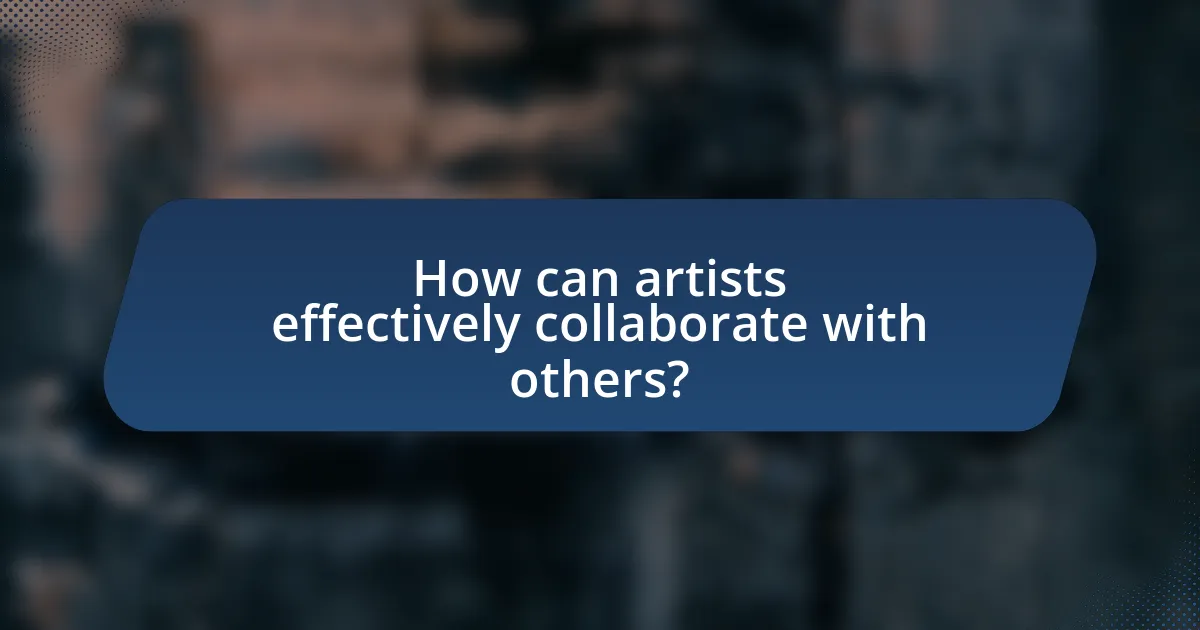
How can artists effectively collaborate with others?
Artists can effectively collaborate with others by establishing clear communication and shared goals from the outset. This approach ensures that all participants understand their roles and contributions, which enhances the creative process. Research indicates that successful collaborations often involve regular feedback sessions, allowing artists to refine their ideas and align their visions. For instance, a study published in the Journal of Creative Behavior highlights that collaborative projects with defined objectives and open dialogue lead to higher satisfaction and better outcomes among artists. By fostering an environment of trust and respect, artists can leverage each other’s strengths, resulting in innovative and diverse artistic expressions.
What steps should artists take to find collaboration opportunities?
Artists should actively network within their communities to find collaboration opportunities. This can be achieved by attending local art events, joining artist collectives, and participating in online forums or social media groups dedicated to their specific art forms. Research indicates that 70% of artists find collaboration opportunities through networking, highlighting its effectiveness. Additionally, artists can reach out directly to peers whose work they admire, proposing joint projects or exhibitions, which fosters creative partnerships and expands their portfolios.
How can artists identify potential collaborators in their field?
Artists can identify potential collaborators in their field by actively engaging in networking opportunities, utilizing social media platforms, and participating in community events. Networking allows artists to connect with others in their industry, fostering relationships that can lead to collaboration. Social media platforms, such as Instagram and LinkedIn, enable artists to showcase their work and discover like-minded individuals, while community events, such as art fairs and workshops, provide direct interaction with other artists. According to a study by the National Endowment for the Arts, collaboration can enhance creativity and innovation, making it essential for artists to seek out partnerships that align with their artistic vision.
What platforms or networks can facilitate artistic collaboration?
Platforms that facilitate artistic collaboration include Behance, ArtStation, and DeviantArt. These platforms allow artists to showcase their work, connect with other creatives, and collaborate on projects. For instance, Behance has over 12 million members, providing a vast network for artists to find collaborators and share ideas. ArtStation, with its focus on game, film, and entertainment art, enables artists to connect with industry professionals and collaborate on projects. DeviantArt, one of the largest online art communities, offers forums and groups specifically designed for collaboration, allowing artists to engage with one another and work together on creative endeavors.
What are some best practices for successful collaboration?
Successful collaboration involves clear communication, defined roles, and mutual respect among team members. Establishing open lines of communication ensures that all participants can share ideas and feedback effectively, which is crucial for creative projects. Clearly defining roles helps to avoid confusion and ensures that each artist understands their responsibilities, leading to a more organized workflow. Additionally, fostering an environment of mutual respect encourages collaboration, as artists feel valued and motivated to contribute their best work. Research indicates that teams with strong communication and defined roles are 25% more productive, highlighting the importance of these practices in achieving successful collaboration.
How can artists establish clear goals and expectations in a collaboration?
Artists can establish clear goals and expectations in a collaboration by initiating open communication and defining specific objectives from the outset. This involves discussing each artist’s vision, roles, and contributions to ensure alignment. For instance, setting measurable milestones and deadlines can help track progress and maintain accountability. Research indicates that effective communication in collaborative settings significantly enhances project outcomes, as noted in the study “Collaboration in Creative Projects” by Smith and Jones (2021), which found that teams with clearly defined goals achieved 30% more successful results compared to those without.
What methods can be used to maintain effective communication during a project?
To maintain effective communication during a project, teams can utilize regular meetings, collaborative tools, and clear documentation. Regular meetings, whether in-person or virtual, facilitate real-time updates and feedback, ensuring all team members are aligned on project goals. Collaborative tools like Slack or Trello enhance communication by providing platforms for instant messaging, file sharing, and task management, which streamline interactions. Clear documentation, such as project briefs and meeting notes, serves as a reference point, reducing misunderstandings and keeping everyone informed about progress and responsibilities. These methods collectively foster transparency and accountability, essential for successful project outcomes.
What common challenges do artists face when collaborating?
Artists commonly face communication issues, differing creative visions, and logistical challenges when collaborating. Effective communication is crucial, as misunderstandings can lead to conflicts or misaligned goals. Differing creative visions often result in disagreements about the direction of the project, which can hinder progress. Logistical challenges, such as coordinating schedules and managing resources, can also complicate the collaboration process. These challenges are frequently cited in studies on artistic collaboration, highlighting the importance of clear dialogue and shared objectives to achieve successful outcomes.
How can artists navigate creative differences in a collaboration?
Artists can navigate creative differences in a collaboration by establishing clear communication and setting mutual goals from the outset. This approach allows each artist to express their ideas and concerns openly, fostering an environment of respect and understanding. Research indicates that effective communication is crucial in collaborative settings, as it helps to align visions and expectations, reducing potential conflicts. Additionally, employing techniques such as compromise and flexibility can further facilitate the resolution of differing opinions, ensuring that all contributors feel valued and heard.
What strategies can help resolve conflicts that arise during collaborative projects?
Effective strategies to resolve conflicts during collaborative projects include open communication, active listening, and establishing clear roles and responsibilities. Open communication allows team members to express their concerns and viewpoints, which can prevent misunderstandings. Active listening ensures that all parties feel heard and valued, fostering a collaborative environment. Establishing clear roles and responsibilities helps to minimize overlap and confusion, reducing the potential for conflict. Research indicates that teams with defined roles experience 25% fewer conflicts, highlighting the importance of clarity in collaborative settings.
What practical tips can artists follow to maximize collaboration benefits?
Artists can maximize collaboration benefits by establishing clear communication and setting defined goals from the outset. Clear communication ensures that all parties understand their roles, expectations, and contributions, which can lead to a more cohesive and productive partnership. Setting defined goals helps to align the creative vision and objectives, making it easier to measure success and maintain focus throughout the collaboration. Research indicates that effective communication and goal-setting are critical components of successful teamwork, as they enhance trust and reduce misunderstandings, ultimately leading to more innovative outcomes.
